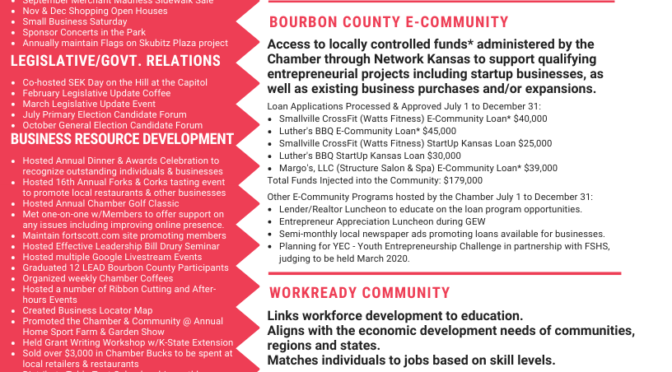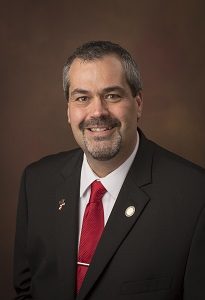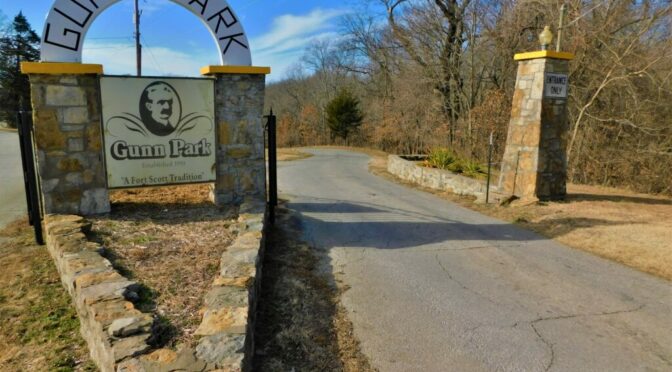Click below:
Monthly Archives: January 2020
Kansas Health Issues Presented
KDHE Secretary Delivers State of Public Health Address
Topeka – Kansas Department of Health and Environment (KDHE) Secretary Lee Norman, MD, delivered “2020: The State of the Health of Kansans” to the Kansas Senate Public Health and Welfare Committee this morning. Dr. Norman will deliver the same presentation to the Kansas House Health and Human Services Committee Wednesday at 1:30 p.m. This is the first time KDHE has delivered such address to the Kansas Legislature.
“As the State Health Officer, it is my duty to look at the health of our state and provide education on what we as a state can do at an individual level, a community level and a government level,” said Dr. Lee Norman, Secretary of KDHE. “Health isn’t just medical care. It’s our behaviors, our environment, our policies and our outcomes.”
Since 1990, Kansas has seen the greatest decline in its health rankings according to America’s Health Rankings published December 6, 2019.
- Behaviors – Kansas ranks #38 in the survey for obesity rates and #30 for smoking.
- Environment – Kansas ranks #21 in the U.S. for the number of children living in poverty. Kansas’ chlamydia numbers are twice the healthiest state, at 465 per 100,000.
- Policy – Kansas ranks #49 in U.S. for females receiving the HPV vaccine and #34 for males. Kansas ranks #32 for children 19-35 months receiving completed vaccines at 69 percent. Kansas ranks 40th for the amount of dollars in public health funding at $60/person. This is 4.5 times less than the top state at $281/per person.
- Medical Care – There is low access to dentists, particularly in rural Kansas. Kansas ranks #38 with 50 dentists per 100,000. Kansas also ranks #35 for mental health providers.
- Outcomes – Kansas ranks in the bottom half on cancer, cardiovascular and diabetes deaths; frequent mental distress; infant mortality; and premature deaths in years lost before age 75.
“What this data suggests is that Kansas needs to improve access to care – addressing the shortage of medical professionals, financial impediments and geographic maldistribution among others,” said Dr. Norman. “It suggests that we have unhealthy behaviors that need to be remedied and that there’s a need for active illness prevention and intervention.”
Dr. Norman continued, “Every Kansan can take steps to improve our state’s health – increase your physical activity, be mindful of proper nutrition and make sure your family is up-to-date on immunizations. It’s also critical that we as a state look beyond ourselves and our families, to our neighbors and community members. It’s time for us to intervene and invest in the health of Kansans.”
Evergy Evaluates Options
Evergy Affirms Board and Management’s Focus on Delivering
Long-Term Value Creation and Serving Stakeholders’ Best Interests
Updates Stakeholders Regarding Dialogue with Elliott Management
KANSAS CITY, Mo. – January 21, 2020 – Evergy, Inc. (NYSE: EVRG), a vertically integrated, regulated, investor-owned electric utility created by the merger of Westar Energy and Great Plains Energy in June of 2018, today issued the following statement regarding the dialogue the Company has had with Elliott Management Corporation (Elliott):
In October 2019, we were approached by Elliott, which proposed two alternative paths for the Company to consider:
- Evergy should immediately initiate a process to explore the sale of the Company or some other business combination;
- Evergy should significantly increase its capex over the Company’s current plan, cut investments in operations and maintenance (O&M) to help offset this increase, and halt its existing share repurchase program.
Since October, we have engaged in good faith with Elliott to fully understand and evaluate their proposals. As a part of this process, we have engaged Morgan Stanley as financial advisor and Morgan, Lewis & Bockius LLP as legal counsel to assist management and the Board with an evaluation of Elliott’s proposals and our strategic plan.
We are open to evaluating opportunities that may create greater value and recognize that Elliott has different views regarding our strategic plan. At the same time, there are various considerations that we believe are important when evaluating the conclusions that Elliott has asserted in its letter.
As expressed to Elliott, we are confident in our ability to deliver long-term growth and shareholder value creation through the execution of our strategic plan. This plan includes maximizing operational savings from our 2018 merger, the share repurchase program we committed to when this merger was completed, paying a competitive dividend and making capital investment that will drive value.
- We are executing on our operating plan and are achieving substantial cost savings. We are on track to exceed the $550 million of cumulative net cost savings targeted through 2023 in connection with the merger. These savings include $110 million of savings in 2019 alone – $80 million above our 2018 target. Notably, these savings are being achieved while protecting jobs; there have been no involuntary layoffs at the Company.
- Merger savings, share repurchases, dividends and infrastructure investments are contributing to sustainable earnings growth and competitive shareholder returns. At this time, given the regulatory considerations in Missouri and Kansas, we believe the greatest return opportunities for Evergy’s capital beyond our current investment plan are share repurchases and growing the Company’s dividend. Together with the Company’s merger savings and incremental infrastructure investments utilizing plant in-service accounting in Missouri, we expect to deliver compounded annual earnings growth of 5% to 7% through 2023.
- Evergy’s third quarter results demonstrate the strength of the Company and the value opportunity we offer to Evergy shareholders. We delivered another solid quarter, despite regulatory headwinds. Our confidence in the business and our financial strength is reflected in the confirmation of our 2019 adjusted EPS guidance of $2.80 to $3.00 and the 6.3% increase to our dividend, also consistent with our long-term guidance.
We remain open to continuing our dialogue with Elliott. As we consider any opportunity, we are resolute in our commitment to serving the best interests of all Evergy stakeholders, including our shareholders, employees, customers and the communities we serve.
The support of our regulators is very important, and we will maintain an open, collaborative dialogue with them as we – and they – consider Elliott’s views.
Morgan Stanley is acting as financial advisor and Morgan, Lewis & Bockius LLP is acting as legal advisor to the Company.
About Evergy, Inc.
Evergy, Inc. (NYSE: EVRG) provides clean, safe and reliable energy to 1.6 million customers in Kansas and Missouri. The 2018 combination of Kansas City Power and Light Company and Westar Energy to form Evergy created a leading energy company that provides value to shareholders and a stronger company for customers.
Evergy’s mission is to empower a better future. Today, half the power supplied to homes and businesses by Evergy comes from emission-free sources, creating more reliable energy with less impact to the environment. We will continue to innovate and adopt new technologies that give our customers better ways to manage their energy use.
For more information about Evergy, Inc., visit us at www.evergy.com.
New export assistance grant available to companies across Kansas
Topeka, Kan. – Companies based in the state of Kansas have a new tool to help them succeed in selling their goods or services to customers around the world. The Kansas Market Access Program (K-MAP) lowers the end-user cost of international market research, export documentation and foreign business partner meetings, so Kansas companies can reach more customers and close more deals.
Emerging out of the public-private partnership between the Kansas Department of Commerce and the Wichita-based Kansas Global Trade Services, K-MAP is made available as a one-time opportunity. Interested companies are encouraged to apply before June 30, 2020, in order to ensure access to grant funding.
“The needs of Kansas exporters vary greatly,” Secretary of Commerce David Toland said. “While Commerce already has a successful program designed to help companies participate in international trade shows (KITSAP), this new program provides assistance for a range of other activities vital to their success.”
Karyn Page, President & CEO of Kansas Global, adds, “We learned what works best when we implemented the state’s first export plan in Wichita. That’s why we asked the Kansas Legislature for this grant to be added to our contact. We found that having a flexible grant for companies to use is the sweetener they need to fast-track international sales.”
For more information about the Kansas Market Access Program and to apply online, visit kansascommerce.gov/k-map-application or kansasglobal.org.
Fort Scott Chamber: Encouraging Businesses
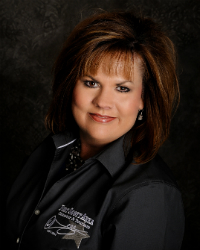
The Fort Scott Area Chamber of Commerce has been working to encourage entrepreneurship and matching skills to local employers’ needs in 2019, according to information provided during the Jan. 9 Chamber coffee.

Two new programs were added to the community this year: Bourbon County E-Community and Work Ready Community. The focus of the two is enhancing local economic development through entrepreneurship and workforce development.
Loans for Businesses Through Entrepreneur Community
Bourbon County E-Community provides access to funds, which are locally administered through the Chamber. These loans included start-up businesses as well as existing business purchases or expenses. The funds are accessed through NetWork Kansas, whose mission statement is to promote an entrepreneurial environment throughout the state that connects entrepreneurs and small business owners with expertise, education, and economic resources.
Those who have received these loans in Fort Scott from July 1 to Dec. 31:
Smallville Crossfit, an E-Community Loan of $40,000.
Luther’s BBQ, an E-Community Loan of $45,000.
Smallville Crossfit, a start-up loan of $25,000.
Lulther’s BBQ, a start-up loan of $30,000.
Margo’s LLC (a salon and spa), an E-Community Load of $39,000.
Other events in support of E-Community: a luncheon to educate on the loan program, an entrepreneur appreciation luncheon, a semi-monthly local newspaper ad promoting the loans, and planning for a Youth Entrepreneurship Challenge, in partnership with Fort Scott High School (judging for the challenge will be March 11, 2020.)
Work Ready Community
Work Ready Community is a nation-wide program to aid matching people to a job that needs their skills and preparing people to have the skills that employers need.
Work Ready Communities is working at the grassroots level to make the country more competitive and closing the skills gap that threatens to paralyze the U.S. economy, according to its website. They do this by providing a community-based framework.
To learn more: /https://www.workreadycommunities.org/
Bourbon County became a Work Ready Community in Sept. 2019.
A group of 10 people from Bourbon County, USD 234, USD235, Fort Scott Community College, the City of Uniontown and local employers attended a Work Ready Community Workshop in August 2019.
Kansas initiated an initiative for high school juniors to take the Work Keys test and earn certification. The certification is to improve hiring and employee retention, help provide employees who have the skills needed and help students attain success in landing a career.
To view the Chamber leadership this year,click below:
http://fortscott.com/board-of-directors
To see the Chamber sponsored events, view the flyer below:
To join the Chamber, click here:
http://fortscott.com/join-the-chamber
Senator Richard Hilderbrand Legislative Report Jan. 17
|
||||||||||||||||||||
|
|
|
|
|
|
The Bourbon County Sheriff’s Office Daily Reports Jan. 21
Legislative Update By State Senator Caryn Tyson

And they’re off… legislators trying to get as much as possible accomplished in 90 days. Our Kansas Constitution limits the legislature to 90 days in even number years.
Property Taxes. You have been telling me that increasing appraisals are automatically increasing your property taxes and I have been listening. This last summer I, with the help of other legislators, have been working on solutions. To increase taxes should require a vote by the commissioners and not automatically increase by the action of the appraiser. Being Chairmen of the Senate Tax Committee, I will be working on this as well as improving the process to appeal property taxes. Bills are being introduced to increase transparency and improve the process. I will keep you updated.
Kansas government has out-of-control spending. Last January, 2019, Governor Kelly submitted her large budget to the legislature and the legislature sent it back to her with $182 million dollars more spending then she requested. She could have line-item vetoed this increase but she didn’t. I did not support last year’s out of control budget and I will not support any reckless budget that spends more than we are taking in.
The Governor promised she wouldn’t raise taxes. A few days ago in this year’s State-of-the-State speech she said she would submit a budget that would honor her promise to cut taxes. However, in her budget presented the next day she asked for sales tax to be put on all digital video, audiobooks, pictures, greeting cards, games, and streaming services. That would increase state revenues by $26.7 million. Sounds like a tax increase to me.
The Governor also proposed $54 million in property tax relief. Kansans pay around $5 billion in property taxes. The $54 million Local Ad Valorem Tax Reduction (LAVTR) the Governor proposed could provide a small temporary cut if local authorities pass the money on to the taxpayer. For example, a property tax bill of $1,000 could be reduced by $10 if all of the LAVTR was passed on to the taxpayer. That would not be a solution for the ever-increasing property appraisals that are automatically increasing your taxes. We need a solution that addresses the heart of the problem and that is what I am bringing forward in the Senate.
What about our President… He brought back prayer in our public schools last week.
It’s an honor and privilege serving as your Senator.
Caryn
Credit Report vs Score
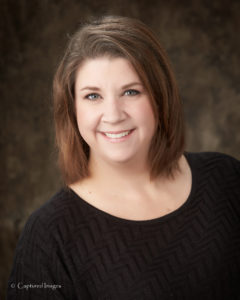
Joy Miller
K-State Research and Extension Southwind District
620-223-3720 or [email protected]
Many people use the terms “credit report” and “credit score” interchangeably, but they are not the same. Your credit report is a detailed account of your credit history, while your credit score is a three-digit number signifying your credit-worthiness. You are entitled to three free credit reports per year, but you generally have to pay to view your score. Although a credit score is a useful piece of information, it is ultimately calculated using the information in your credit report. Therefore, paying for a credit score is typically unnecessary, but ensuring the accuracy of the underlying data in the report is crucial.
What is a credit report? Your credit report is a collection of all of your credit activities within the past 7-10 years. It includes your payment history for your credit cards and other loans such as auto loans and mortgages; public records related to your finances such as bankruptcies, tax liens, and court judgements; and a record of everybody who has looked at your report within the past two years. You can request one free credit report every year at AnnualCreditReport.com from each of the three main credit agencies: Equifax, Experian, and TransUnion. Companies use the information in your credit report to calculate credit scores.
What is a credit score? Your credit score is calculated using the information in your credit report. Financial institutions use your credit score to decide whether to offer you a loan or credit card. Your credit score also determines the interest rates and credit limits that financial institutions offer to you. Although many people believe they have one credit score, in fact everybody has several credit scores–different companies calculate your credit score in different ways. Your scores change constantly based on your financial activities. Regardless of the agency, your score will consist of five main components: payment history, amount of current debt, length of credit history, amount of new credit, and types of credit used. Companies use each of these components to calculate a three-digit score, ranging from a low around 300 to a high around 900, which again varies across different types of scores. In the United States, the most widely used credit score is the FICO score. Your credit score is not available for free through AnnualCreditReport.com.
How can I improve my score? You can improve your score by paying your bills on time, using less of your available credit balance, not opening multiple credit accounts over a short period of time, keeping older credit cards open, and using different types of credit responsibly.
It is important to check your credit report regularly to make sure it is accurate and up-to-date. K-State Research and Extension Check Your Credit email program is free and registration is easy, visit southwind.k-state.edu under Upcoming Events.
Not Complaining, Doing Acts of Service
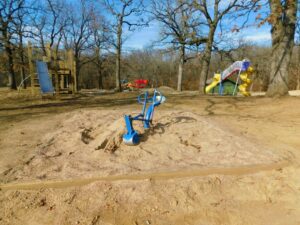
Some local citizens have decided not to complain about issues, but instead to work on solutions.
Citizens For Park Improvements is the name of a group of local citizens who had been working in Gunn Park to improve the children’s areas.
Saw the need, took action
“The weekend before I started the group, we were at the park for a church function,” Seth Needham said. ” My youngest wanted to swing, but he couldn’t because the swings were broke. Even if the swings weren’t broke, the surface was muddy, and the whole area was unsafe. The swings that weren’t broke were 28 inches off the ground, which isn’t safe for a toddler. So, I decided to take action.”
” I have 2 sons, and I want the park to be a fun place for them.”
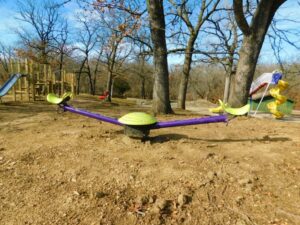
“It is something that had been on my mind for quite some time,” Needham said. ” I love our parks. I love taking my sons to our parks. But our parks need a lot of work. As I parent who frequents the parks, I see a lot of the issues. And I wasn’t seeing those issues being addressed. Things like a teeter-totter that was 40 inches off the ground, which was dangerous for my sons. Or slides that my two-year-old couldn’t go down because they had huge drop-offs at the bottom. Swing sets that were in disrepair. Ground covering that is non-existent. I realized I had two choices; gripe and complain on Facebook, or take action. I chose the second.”
“We have good parks,” he said. “But we have the basis for GREAT parks. And that’s what I want. I want to see Gunn Park be a wonderful safe place for families. I believe our parks department is doing a great job, but it sounds like they are overwhelmed sometimes just trying to keep up with the day-to-day operations. I figured if I could organize a group of people to help with some of the small stuff, the park department might have more time to focus on the larger issues.”
Started November 2019: More Projects In Spring
Needham started the project on November 6.
“I figured a few people might join and help, but I never expected it to take off like this. We have had one meeting, are already drawing up plans for our first six projects. We had our first workday, and got several projects done.”
Upcoming projects planned for this spring include updating bathrooms, repairing playground equipment, new ground cover for playgrounds, “and also some bigger projects which will really add to Gunn Park,” Needham said. “We have people looking into funding options, have set-up a material registry with Big-Sugar Lumber, and have experts looking into things such as drainage. And there is so much more that is going on.”
Currently, there is a project to clear off the Bell Town Park Trail on the north end of town, being organized by Denise Findley Needham.
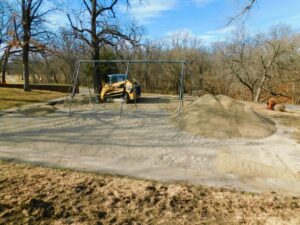
“Right now there are around 500 people in the group, and it’s growing daily,” he said. “We have a good group of people with fresh ideas, and the will to make it happen. One of my goals from the beginning was to make the group accessible to anyone. I want anyone who wants to help to have the opportunity, regardless of age, income, physical health, or time. I’m trying hard to organize the group where someone who has to work weekends can still contribute if they want to. Or the person who has $10 leftover after pay-day, but still wants to help. There will be a place for them. Or maybe someone who is older or disabled and can’t get out there and do physical labor…. We can use them too.”
Leadership
” We have never really decided on leadership,” he said. “I guess right now, I’m it. There have been several individuals who have really stepped up… and I couldn’t have done it without them. So if that qualifies as a leader, I would have to say Craig Campbell, Deb McCoy, Josh Jones, Beth Nuss, Lindsay Madison, Susan Bancroft, and Chad Brown so far. As projects come up, I am sure we’ll see more people step up to the plate when they see a need for something they are great at. “
Social media is helping the organization
“I organized it through Facebook to make it easier for people. Let’s face it, people are busy. It’s hard to attend traditional meetings. But by organizing it online, people can contribute on THEIR schedule. Ideas can be exchanged easily. We can set-up events so that people can see what we need, when we are working, and how they can help.”
To view the group’s page:
https://www.facebook.com/search/top/?q=Citizens%20for%20Park%20improvemnts&epa=SEARCH_BOX
“If anyone wants to be involved, they just need to join our Facebook group,” Needham said. “In the group, we post ideas and solutions we are working on, workdays, and how people can help.”
Fort Scott City Commission Agenda Jan. 21 Updated
AGENDA
FORT SCOTT CITY COMMISSION
FORT SCOTT CITY HALL
COMMISSION ROOM
123 SOUTH MAIN
JANUARY 21, 2020
6:00 P.M.
I. ROLL CALL:
K. ALLEN P. ALLEN NICHOLS WATTS MITCHELL
II. FLAG SALUTE:
III. INVOCATION: Pastor Paul Rooks, Grace Baptist Tabernacle
IV. PROCLAMATIONS/RECOGNITIONS:
V. CONSENT AGENDA:
-
Approval of minutes of the regular meeting of January 7th, 2020.
-
Approval of Appropriation Ordinance 1254-A totaling $805,509.03.
-
Request to Pay #2 – Strukel Electric, Inc. – $125,107.65 (Electric Vault Building – Airport)
-
Consideration of Pay Request #5 – Crossland Construction – River Intake Project – $242,379.46
VII. APPEARANCE/COMMENTS/PUBLIC HEARING:
-
APPEARANCE: Don George, Kansas Department of Wildlife & Parks
B. CITIZEN COMMENTS (Concerning Items Not on Agenda – 3 minute limit per citizen)
C. PUBLIC HEARINGS/COMMENTS: None
VIII. CONSIDERATION:
-
Consideration of approval of final plat for the property more commonly known as 401 Woodland Hill Boulevard – Approval of Ordinance No. 3557
-
Consideration of Contract with Suez Treatment Solutions for SCADA upgrades to the ozone system at the Water Treatment Plant
-
Consideration of purchase of Composite Wastewater Sampler to obtain samples for K.D.H.E. and waive the bidding process
-
Consideration of approval of Joplin Toolbox Contract for 2020 sanitary sewer work.
-
Consideration to solicit bids for cleaning and repainting of aquatic center pool
-
Consideration of Audit contract for 2019 with Diehl, Banwart & Bolton
IV. COMMENTS:
- Director Updates:
- Commission:
- City Manager:
EXECUTIVE SESSION:
I MOVE THAT THE CITY COMMISSION RECESS INTO EXECUTIVE
SESSION FOR ________________________________ IN ORDER TO
(see below justification)
DISCUSS ______________________________________. THE
EXECUTIVE SESSION WILL BE ___________ MINUTES AND THE OPEN
MEETING TO RESUME AT ________________.
Justifications for Executive Sessions:
-
Personnel matters of non-elected personnel
-
Consultation with an attorney for the body or agency which would be deemed privileged in the attorney-client relationship
-
Matters relating to employer-employee negotiations whether or not in consultation with the representative or representatives of the body or agency
-
Confidential data relating to financial affairs or trade secrets of corporations, partnerships, trusts and individual proprietorships
-
Preliminary discussions relating to the acquisition of real property
IV. MOTION FOR ADJOURNMENT: ROLL CALL
Cold Stress on Cows
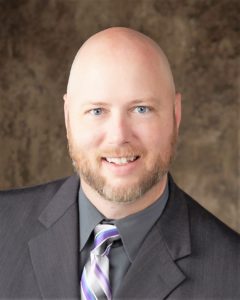
A cow’s body conditions affects cold stress.
According to Mary Drewnoski, University of Nebraska Beef Systems Specialist, cold stress increases a cow’s energy requirement and can pull down her body condition. We think many cow/calf producers will experience this issue this winter. While we don’t know what mother, nature has in store for us this year, it is good to think ahead and have a plan. A good start is to evaluate body condition score (BCS) now, and if cows are not at a 5 to 5.5 body condition score, then taking steps to improve body condition score before cold weather hits can help reduce the impacts of cold weather on the cows. Your local extension agricultural agent can assist you determining the body condition score of your cattle if needed.
The threshold at which cattle have to start using energy to maintain their body temperature is called the lower critical temperature (LCT). Cows in good condition which have a heavy winter coat that is dry, do not need to use extra energy to maintain body temperature until the wind chill index is below 19°F.
Having cows in good body condition is a risk management strategy and affects the lower critical temperature. A thin cow with a body condition score of 4 and a dry winter coat has a lower critical temperature of 27°F versus the 19°F of a cow in body condition score 5. Getting cows into good condition early in the winter can be useful for managing risk of bad weather, in that they have condition they can lose, but also because cows with higher body condition score will lose less than those with lower body condition. Additionally, a practical management strategy may be to consider putting thin cows in a group with your first calf heifers as both have higher energy requirements in the winter, which can allow for strategic supplementation of extra feed.
It is also important to understand that a wet hair coat is a completely different ball game. A wet coat increases the lower critical temperature of a cow in good condition to 53°F. Thus, anytime a cow’s coat is wet in the winter they will be using more energy to maintain body temperature. Therefore, in winters with more precipitation, especially freezing rain, we often see much greater decreases in body condition score.
By providing wind protection, you can decrease energy needs by removing wind as a negative factor. If cows have protection from wind, the ambient temperature can be used to determine energy needs. Providing wind protection in the winter can be huge for reducing supplementation needs due to cold wind chills.
It is not advisable to change rations daily, but for extended cold or wet periods, consider feeding more of the same ration, if cattle can eat more of the typical ration. If not, then providing an energy supplement is a good idea. When feeding lower quality hay, dormant range or corn stalks, additional feed will be needed. One option is to change to feeding a higher quality hay source, if available. Free choice really high-quality hay can work down to temperatures of -15°F for cows in good body condition with dry hair or 19°F with good body condition and wet hair. Only by forage testing can you determine actual nutritional value, see your extension office for more information about forage testing.
If cows are grazing, then supplementation with a high energy feed may be desirable. While corn can be used to provide more energy, it comes with risk. Feeding more than 2 to 3 pounds per animal per day can decrease forage digestion, and upset stomachs, especially if the forage is lower in protein. This means that one could make up the difference of about 15°F between the lower critical temperature of the cow and the wind chill index temperature. For a cow in body condition score of 5 with a dry coat, corn supplementation would cover the increased energy requirement down to 5°F, or for a cow with a wet hair coat only to about 38°F. If using corn, it should be fed daily, starting with a low amount, and slowly increased over time.
Distillers grains are another option. Distillers is a good source of energy, it has more energy than corn, and because it is high in protein, it does not cause as much of a substitution effect (will not decrease intake of the forage much) Limitations on the amount of distillers that could be fed would be more based on budgetary concerns than digestive effects.
When wind chill temperatures are extremely cold or the cow has a wet hair coat, a lot of supplement would be needed to make up the greater energy needs and maintain body condition. For instance, if the wind chill was -10°F and the cows had a wet hair coat, 8.6 pounds of dry distillers would be needed to account for the increased energy requirement. However, feeding these levels is likely impractical. A better approach would be to provide a smaller amount of supplemental feed and to continue to feed the extra feed after the weather has moderated to allow cows to regain energy lost during the storm.
It is also important to remember that milking cows have a much greater energy requirement than pregnant cows, not yet milking. Given this, the combination of cold stress and lactation can pull down body condition score very quickly. Thus, if lactating (milking) cows are also subjected to cold stress, increasing their energy intake prior to observing noticeable loss of body condition is advisable. For questions on body condition scoring, lower critical temperature, or supplemental feeding, contact your local extension office.
